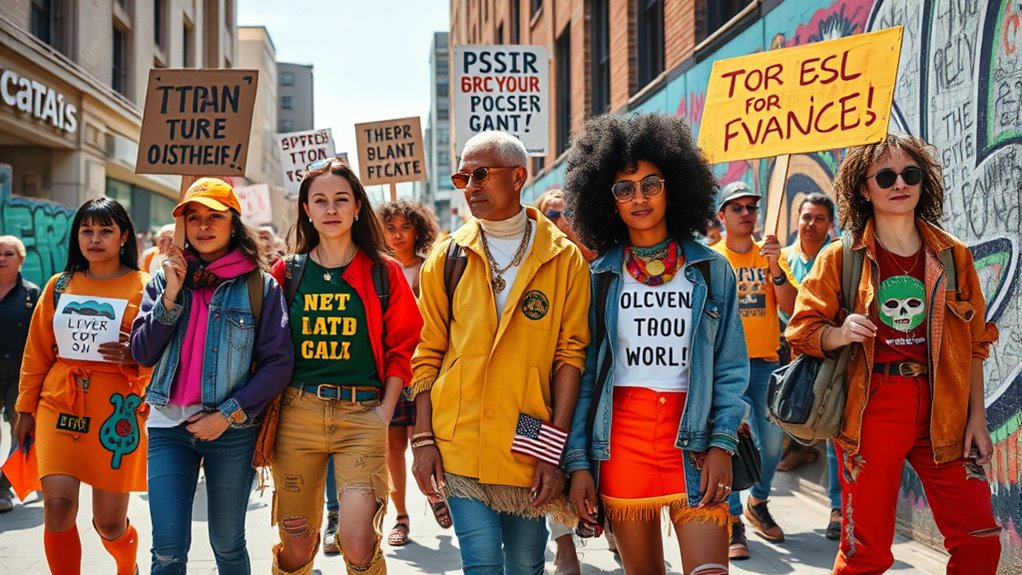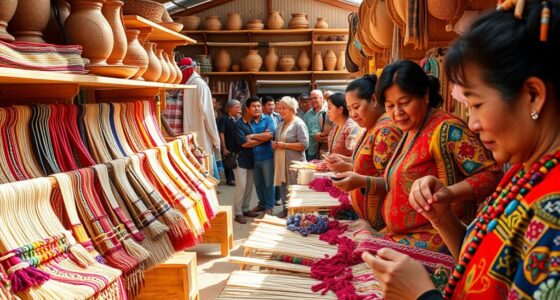Fashion activism lets you turn your wardrobe into a statement for social change. By choosing sustainable, ethically sourced clothes, you support fair labor practices and push brands toward eco-friendly practices. Your style can spark conversations on social justice and environmental issues, showing your values through what you wear. When you focus on responsible fashion, you contribute to a more equitable and sustainable industry. Keep exploring how your fashion choices can be powerful tools for activism.
Key Takeaways
- Fashion serves as a platform for activism, allowing individuals to make social statements through clothing choices.
- Choosing sustainable and ethically sourced garments raises awareness and encourages responsible industry practices.
- Wearing fashion that reflects social values promotes conversations about social and environmental justice.
- Fashion activism supports fair labor, ethical sourcing, and eco-friendly materials, influencing industry standards and consumer behavior.
- Style can be a powerful form of advocacy, transforming wardrobes into tools for social change and industry transformation.

Have you ever wondered how fashion can spark social change? It’s more than just trends and aesthetics; it’s a powerful platform for activism and awareness. When you choose clothing made from sustainable materials, you’re making a statement about your values and support for a healthier planet. Sustainable materials like organic cotton, recycled fabrics, and plant-based fibers reduce environmental impact and promote eco-conscious practices. By opting for these options, you’re encouraging brands to prioritize eco-friendly production processes, which can lead to a significant shift in the industry. This choice isn’t just about personal style—it’s about demanding accountability from fashion companies and fostering innovation that benefits both the environment and communities. Ethical sourcing is equally vital in this movement. When you pay attention to where your clothes come from, you support fair labor practices and workers’ rights. Ethical sourcing ensures that materials are harvested and produced in ways that respect human dignity, avoid exploitation, and promote fair wages. By choosing brands committed to transparency and ethical standards, you send a clear message: consumers care about how their clothes are made. This can push larger brands to reevaluate their supply chains and adopt more responsible practices. Additionally, understanding the importance of halal sourcing in the fashion industry can inspire more inclusive and diverse ethical standards. When you wear fashion that emphasizes sustainability and ethical sourcing, you become part of a larger conversation. Your wardrobe becomes a tool for activism, showcasing your stance on social issues and encouraging others to follow suit. The impact isn’t limited to individual choices; it extends to the industry at large. As more consumers demand ethical and sustainable options, companies are compelled to innovate and improve their practices. This ripple effect can lead to a more equitable and environmentally friendly fashion landscape. Additionally, supporting brands that prioritize sustainable materials and ethical sourcing often means investing in higher-quality, longer-lasting clothing. This not only reduces waste but also challenges the fast fashion cycle that promotes disposable clothing. Your conscious purchasing decisions can help shift the focus from quantity to quality, emphasizing durability and timeless style over fleeting trends. Ultimately, fashion activism is about recognizing the power of your choices. Every time you select ethically produced garments made from sustainable materials, you’re contributing to a broader movement for social and environmental justice. Your style becomes a form of advocacy—an expression of your commitment to positive change. By aligning your wardrobe with your values, you become a catalyst for transformation within the industry, proving that fashion can be a force for good.
Frequently Asked Questions
How Can Individuals Start Their Own Fashion Activism Initiatives?
You can start your own fashion activism initiatives by engaging in DIY projects that reflect your values and inspire others. Share your creations on social media to raise awareness and spark conversations. Get involved in community engagement by collaborating with local groups or hosting events that promote social change through fashion. By combining these efforts, you’ll build a movement that encourages others to use style as a platform for activism.
What Are the Ethical Considerations in Fashion Activism Campaigns?
You must consider ethical issues like sustainable sourcing and fair labor in your campaigns. Ignoring these can undermine your message and harm vulnerable workers. Will you risk supporting brands that exploit or damage the environment? By prioritizing transparency and responsible practices, you guarantee your activism truly promotes positive change. The stakes are high—your choices can inspire others or perpetuate harm. Choose wisely, and let your style speak responsibly.
How Do Brands Measure the Impact of Their Activism Efforts?
You can measure your activism efforts’ impact by tracking brand metrics like engagement rates, social media shares, and changes in consumer sentiment. Impact evaluation involves analyzing data before and after campaigns to see shifts in awareness or behavior. By setting clear goals and collecting relevant data, you guarantee your initiatives are effective, revealing how well your brand promotes social change and resonates with your audience.
Can Fashion Activism Influence Policy Changes Effectively?
You can influence policy changes through fashion activism, especially when you leverage grassroots movements and policy advocacy. Studies show that 62% of social movements gain momentum through visible activism, like fashion statements. When you use style to raise awareness and mobilize communities, you create pressure on policymakers. Your involvement can spark dialogue, inspire action, and ultimately lead to meaningful policy shifts, proving that fashion activism can be a powerful tool for social change.
What Are Some Common Challenges Faced by Fashion Activists?
You face challenges like consumer resistance, where people may not support or understand your message, making it hard to create impact. Resource constraints also hinder your efforts, limiting access to funding, materials, or platforms needed for activism. Balancing creative expression with social messages can be tough, especially when you’re trying to stand out. Despite these hurdles, persistence and strategic collaborations help you overcome obstacles and push your activism forward.
Conclusion
By embracing fashion activism, you hold the power to ignite unstoppable waves of social change. Every bold outfit, every statement piece, becomes a weapon in your arsenal for justice and equality. Don’t underestimate your influence—your style can shake the very foundations of society and inspire millions. When you wear your values proudly, you become a force so fierce, it’s like a tidal wave of progress sweeping over the world. Your fashion choices can change everything.









